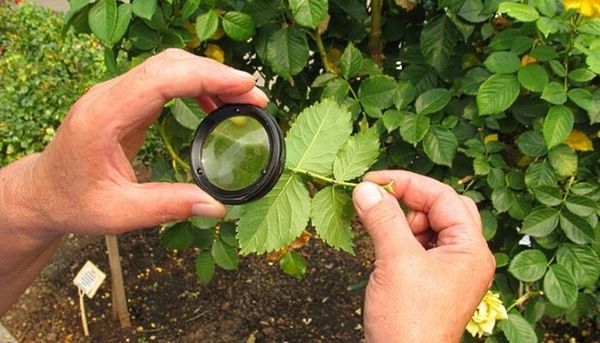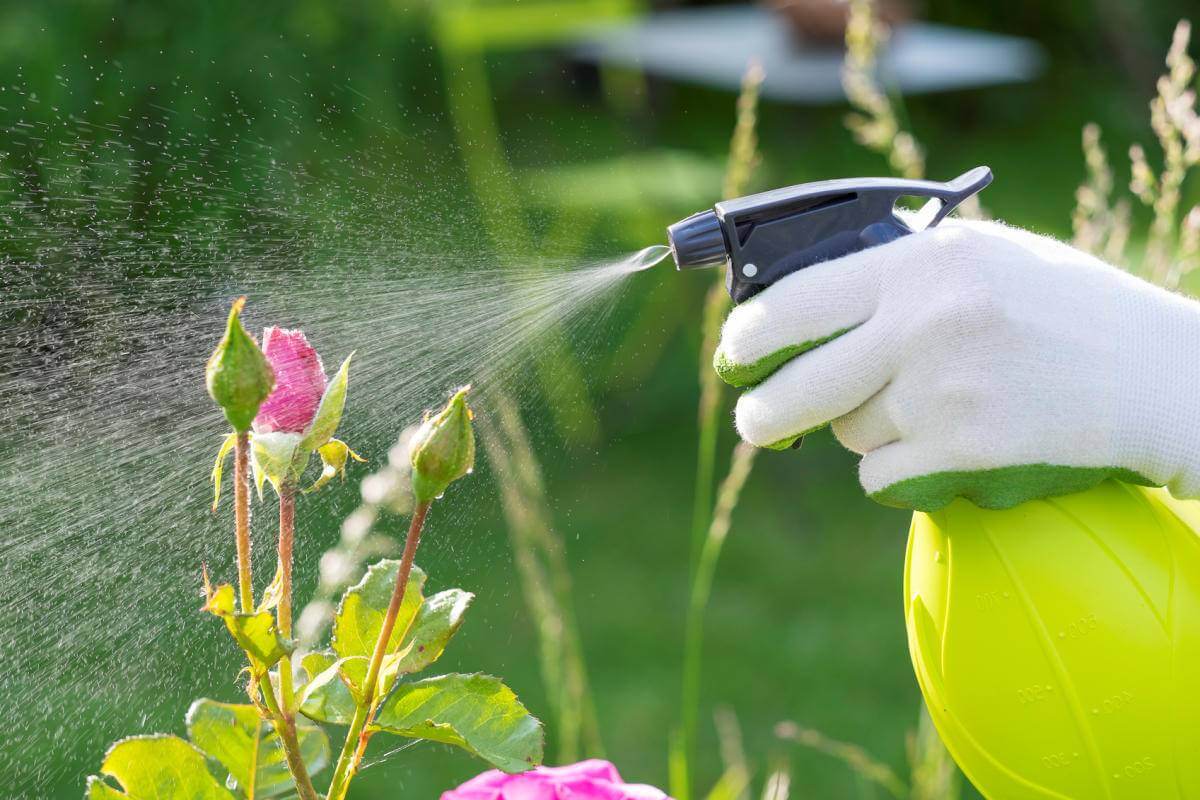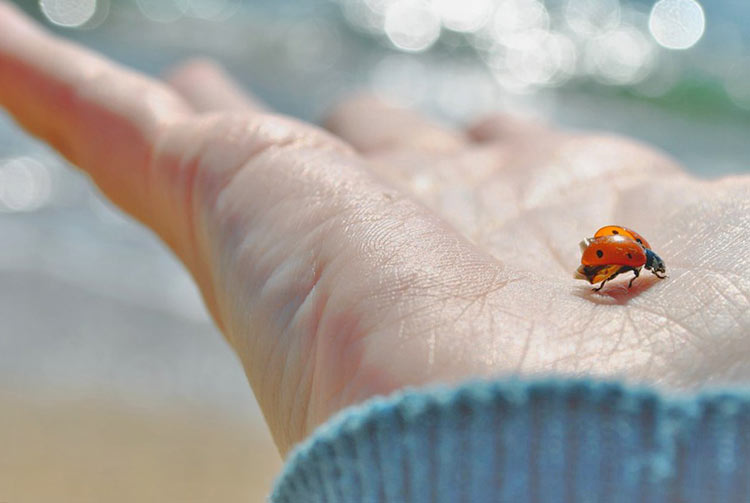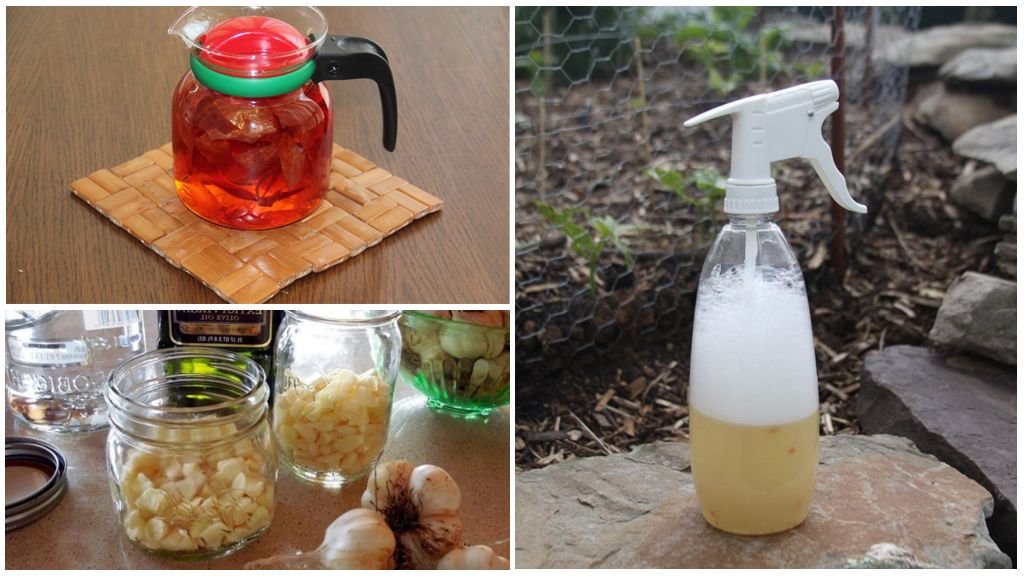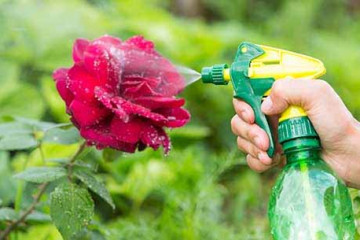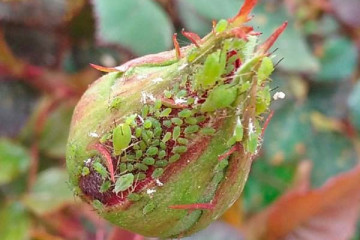Spider mite on a rose - how to deal with it at home
Content:
A spider mite on a rose is one of the most destructive parasites for a plant, which in a short time drinks all the juices of a flower, leading to its destruction. Getting rid of the pest is difficult and long, so it is so important to regularly inspect the roses and, at the first appearance of bugs, take measures to eliminate them.
Spider mite on a rose
The insect settles on both home and garden flowers. The tick affects various plants, but most of all it loves strong and juicy roses. The difficulty in eliminating the parasite is that it develops rapidly, and although its life span is short, up to 1 month, during this time the female manages to lay thousands of eggs.
How a tick gets on a flower
Ticks are carried by the wind, which carries them from one plant to another.
The insect is brought into the apartment on shoes and items of clothing, with the wind - through the windows.
Brief description of the pest
It is difficult to notice a spider mite on a rose in time until the first symptoms of plant infection appear. The parasite is microscopic in size. Brief description of the pest:
- the shape of the body is oval, the number of legs is 8, the limbs are located in 4 pairs on both sides;
- size of an adult: females - from 0.4 to 0.6 mm, males - up to 0.4 mm;
- body flat below, slightly convex above, covered with fine, soft bristles;
- color - at the larval stage, the body is transparent, the adult mite is light green or green with a brown tint, dark spots are located on the sides.
Why is the tick called spiderweb
The mite got its name because, settling on a plant, it begins to weave numerous threads of a cobweb, quite dense, which in a short period can completely cover a rose.
Habitat
The parasite lives all over the globe. The only place where it is not is Antarctica.
Reproduction of offspring
In early spring, ticks begin to multiply actively. The female lays about 7 eggs per day, which she attaches to the threads of the cobweb or foliage. Egg diameter 1 mm. Reproduction rate depends on climatic conditions. Ticks show maximum activity at a temperature of about +25 degrees. In tropical latitudes and in greenhouses, parasites reproduce all year round, reproducing offspring every month.
Signs of a rose mite infestation
If the tick itself is difficult to see due to its small size, then the consequences of the defeat of the rose are clearly visible. There are a number of signs that indicate a plant infection with a parasite:
- The rose gradually fades, becomes painful in appearance.
- The leaves are covered with a bloom of white, which gradually increases in diameter and eventually forms into separate spots.
- The appearance of thin threads of a cobweb.
- Twisting the leaf plates, after which they begin to dry out.
- The foliage becomes pale and yellow.
- Inflorescences decrease in size, become weak.
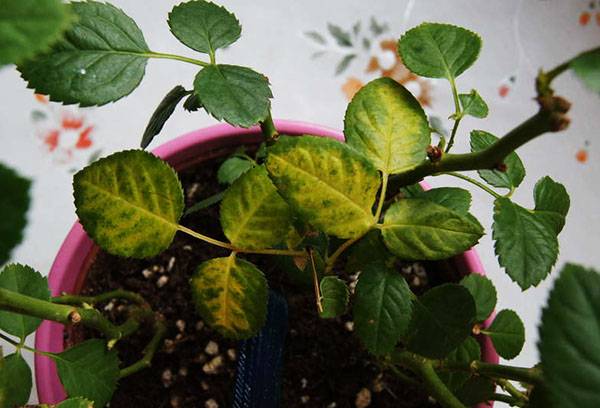
You can understand that a rose has become a victim of a tick by the suddenly changed type of foliage.
When the first symptoms of infection are detected, it is necessary to urgently take measures to eliminate the parasite, otherwise the rose will die in a short period of time.
White spots on the leaves
White spots begin to appear due to the fact that the parasite sucks the sap from the plant cells. Gradually, cells die off, metabolic processes are disrupted, and the leaf plate dies off. The suction of the juice negatively affects the entire flower, it weakens, becomes too susceptible to various diseases.
Withering and yellowing of foliage
After the appearance of white spots, the leaf plate, devoid of juice, begins to turn yellow and curl. First, individual leaves fall, but as the tick colony spreads throughout the flower, a massive leaf fall occurs.
The presence of a web
If the wilting of foliage and its fall is not a specific sign, since such a symptom is characteristic of many parasites, then the presence of a cobweb on a street rose or indoors leaves no room for doubt.
The web spreads gradually. At first, these are several thin threads, then their number increases, and soon the whole flower is covered with it.
Spider mite control methods
The spider mite is the most dangerous parasite for the rose, which not only destroys the plant where it settles, but also quickly spreads to neighboring flowers. It is difficult to deal with it, but it is possible if measures are taken in a timely manner.
Isolation of plants in the garden and at home
As soon as a cobweb was noticed on domestic roses, they must be immediately isolated in a separate room. This is done in order to prevent the spread of the parasite to other plants.
It is more difficult to make insulation in the garden. The rose bush can be covered with a darkening net or agrofiber.

A jet of water will help to knock off most of the parasites from the roses, which will greatly facilitate further war with them.
Cardinal pruning of the bush
The affected parts of the rose cannot be restored. They need to be trimmed.
Cleansing foliage from cobwebs
The cobweb from the bush is removed manually, it can be wound on a stick. Small parts of the threads are washed off with water under pressure.
Spraying
Soap solution is highly effective in removing mites and cobwebs. They need to spray on infected bushes.
A cobweb appeared on the rose, what to do at home - folk methods
You can rid the plant of the parasite using folk methods and specialized purchased means. The first is preferred because they are safer. But recipes from natural products show effectiveness only in the early stages, when the parasite colony is not too large.
Onion tincture
Pour 100 g of onion husks with 5 liters of hot water. Insist for 5 days, then strain. Spray the bushes liberally. Repeat the procedure every 2 days until the tick is destroyed.
Dandelion decoction
Spider mites do not tolerate the smell of dandelions, and upon contact with it, they will prefer to leave the bush. To prepare the broth, you need to pour 2 liters of water 40 g of medicinal dandelion, insist for 5 hours.
Garlic tincture
Garlic tincture, which will help eliminate the parasite from roses, can be prepared according to several recipes:
- Grind a garlic head, pour 10 liters of hot water over it. Use only after the liquid has cooled completely.
- Grate the garlic. Pour 50 g of the ingredient with 3 liters of water, put the container in a dark place. Insist for 7 days. Strain. The resulting concentrate must be diluted before use - pour 60 g of the prepared solution with 10 liters of water.
- Finely chop the garlic head, pour 10 liters of slightly warmed water. Insist for several hours, strain.
Soap solution
Laundry soap solution is one of the most popular and quite effective ways to eliminate any parasites on roses, including spider mites. Recipe:
- Grind a piece of laundry soap on a grater.
- Fill with water, shake the container well until foam forms.
- Apply the prepared solution to the bush through a spray bottle.
Recommendations for using a soap solution to help improve its effectiveness:
- Instead of laundry soap, you can use tar.
- It is necessary to process with a solution not only the green part of the bush, but also the stem, as well as the ground under the plant.
- After 4 hours, the white bloom formed from the soap must be washed off with a stream of water and cover the plant with a film for a day.
The use of predatory insects
It is possible to eliminate spider mites from the plant by attracting insects, which are the natural enemies of the parasite. These insects include:
- ladybug;
- lacewing;
- riders;
- bedbugs;
- common earwig.
These insects will help save the flower if you attract them to the site. To lure predators, you can use the following tricks:
- Plant flowering plants, as insects need nectar for reproduction.
- If possible, leave a few weed bushes on the site in which lacewings like to breed.
- Sow chamomile, dandelion, coltsfoot, oregano and rosemary.
In the summer, hay pots can be placed on the site. The same recommendation can be used for flowers in the house. In winter, hay can be placed in a pot with a Chinese rose and other homemade varieties of flowers.
Spraying preparations
If a spider web is found on a garden rose, what should I do? With extensive damage to the flower, recipes based on natural products will not help, therefore, you have to resort to purchased drugs. The best chemicals for treating roses are:
- "Actellic" is a potent drug that is used only in extreme cases, when other methods do not work. When used on home flowers, processing is carried out only on the balcony, where there should be no animals and children. The gardener, when working with Aktellik, must wear gloves and protect the organs of sight and respiration.
- "Fitoferm" - shows high efficiency in relation to larvae and adults. Used once a week until the complete disappearance of the parasite.
- "Neoron" - destroys eggs, larvae and adult ticks. The drug is used 2 times with an interval of 1 month.
Other drugs recommended for tick killing:
- "Fufanon";
- "Demitan";
- "Karate";
- Sunmight;
- Apollo.
Prophylaxis
In order not to have to think about how to deal with a spider mite on a rose at home, it is necessary to observe preventive measures and properly care for flowers. Simple measures will help prevent the appearance of the parasite, from which the roses begin to dry, and then die:
- Periodically wash the plant with a stream of water.
- Isolate the purchased rose from other plants for several weeks.
- Maintain an average level of humidity, the air in the room should not be too dry.
- Remove dead foliage from the site and burn it.
- Inspect roses weekly for vermin.
The spider mite is a parasite that is destructive to roses. Indoor plants are extremely difficult to cure and restore after an insect. The higher the chances of salvation are roses that grow on the site. Knowing what a flower infected with a tick may look like, it is necessary to immediately begin to fight against it, until the parasite colony has increased. It is important not to forget about regular preventive measures.

